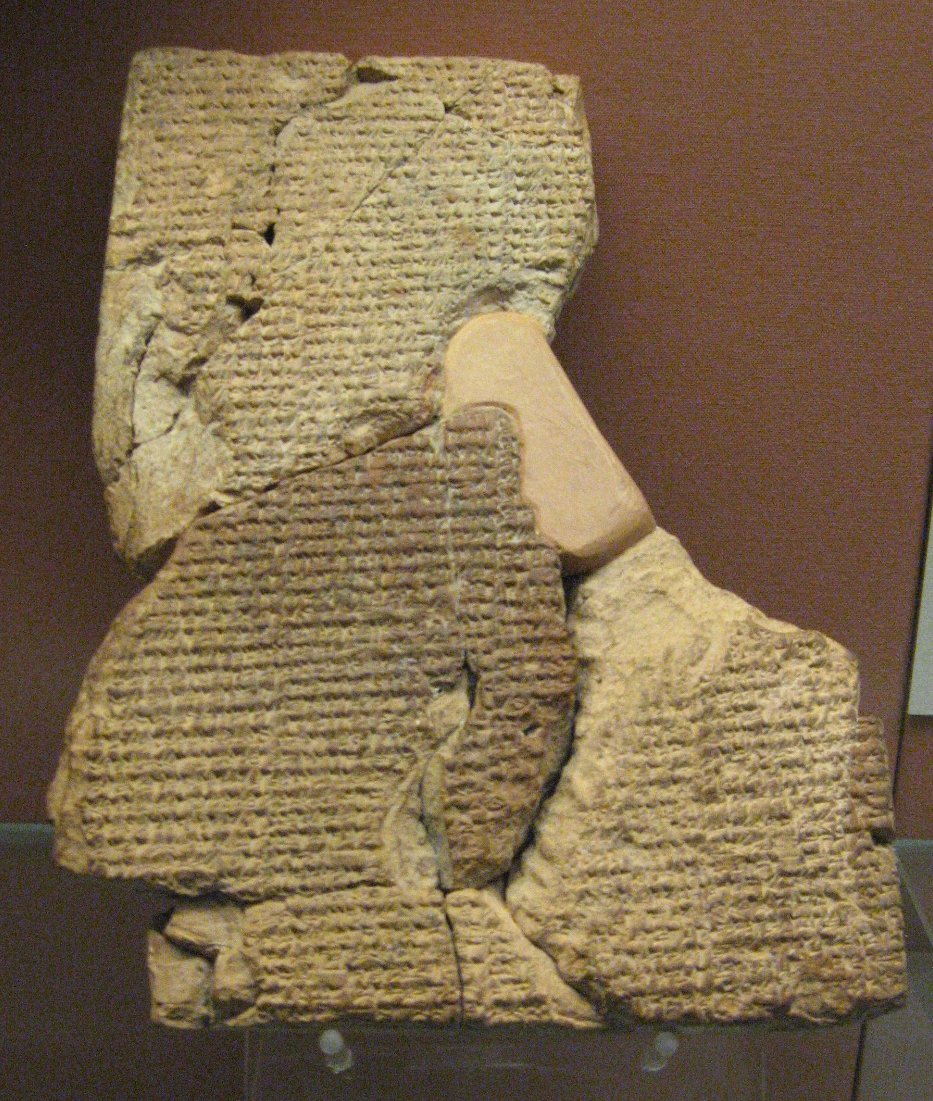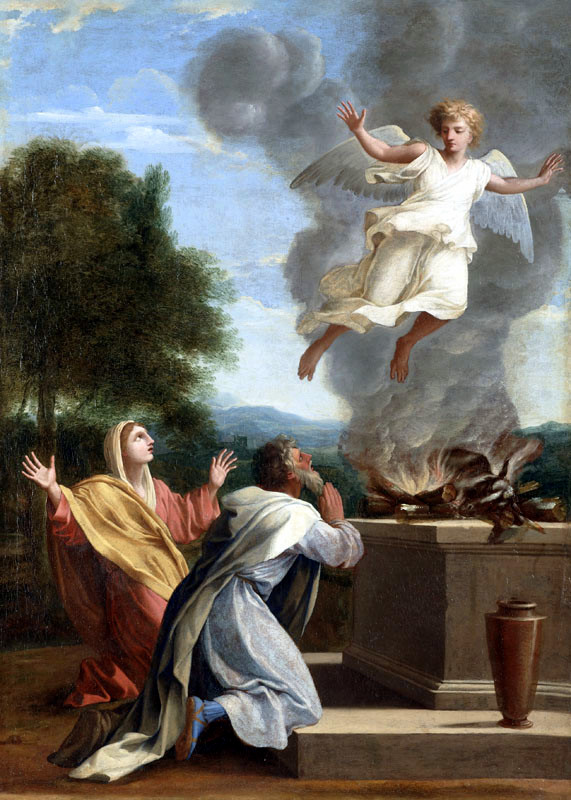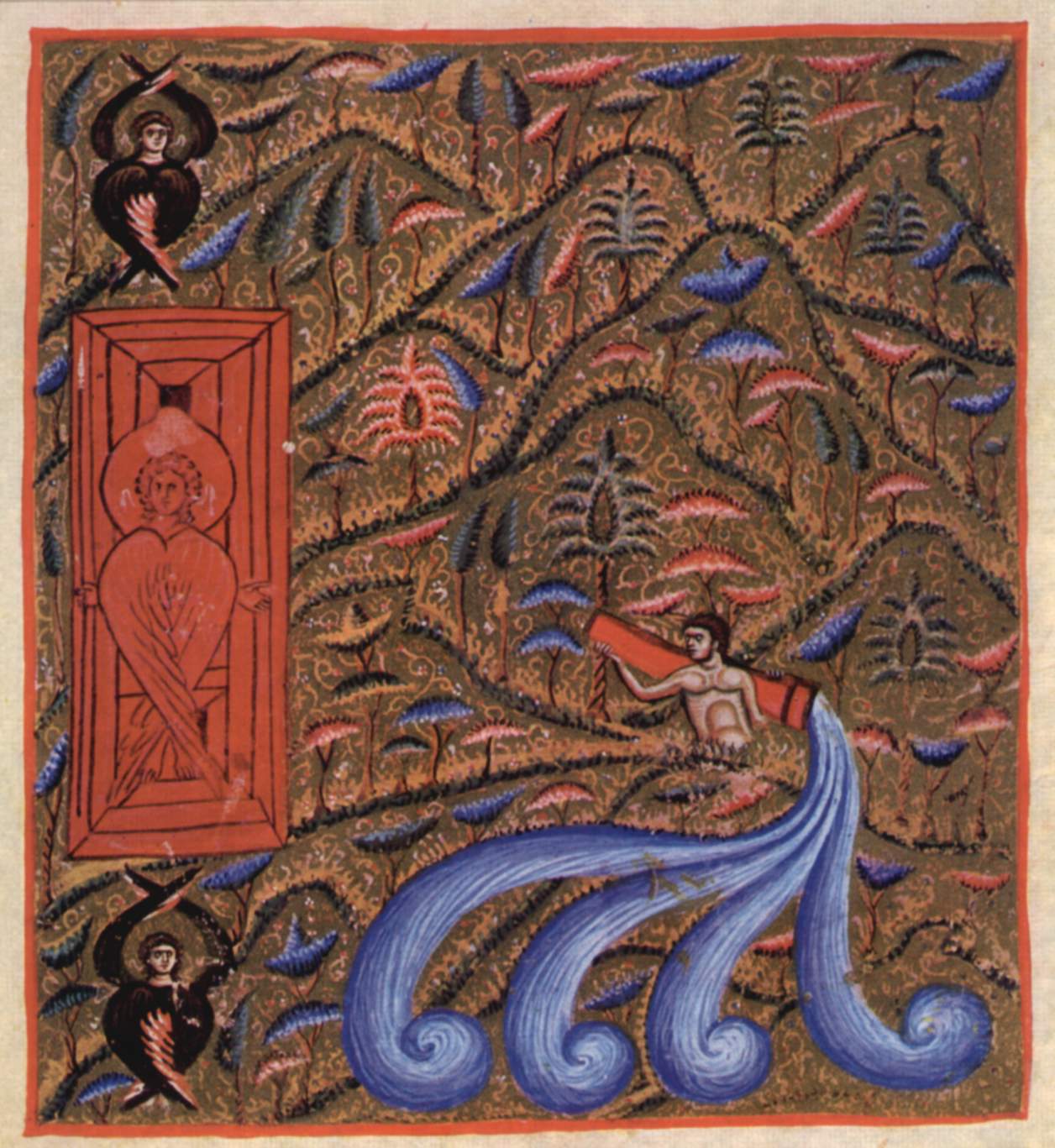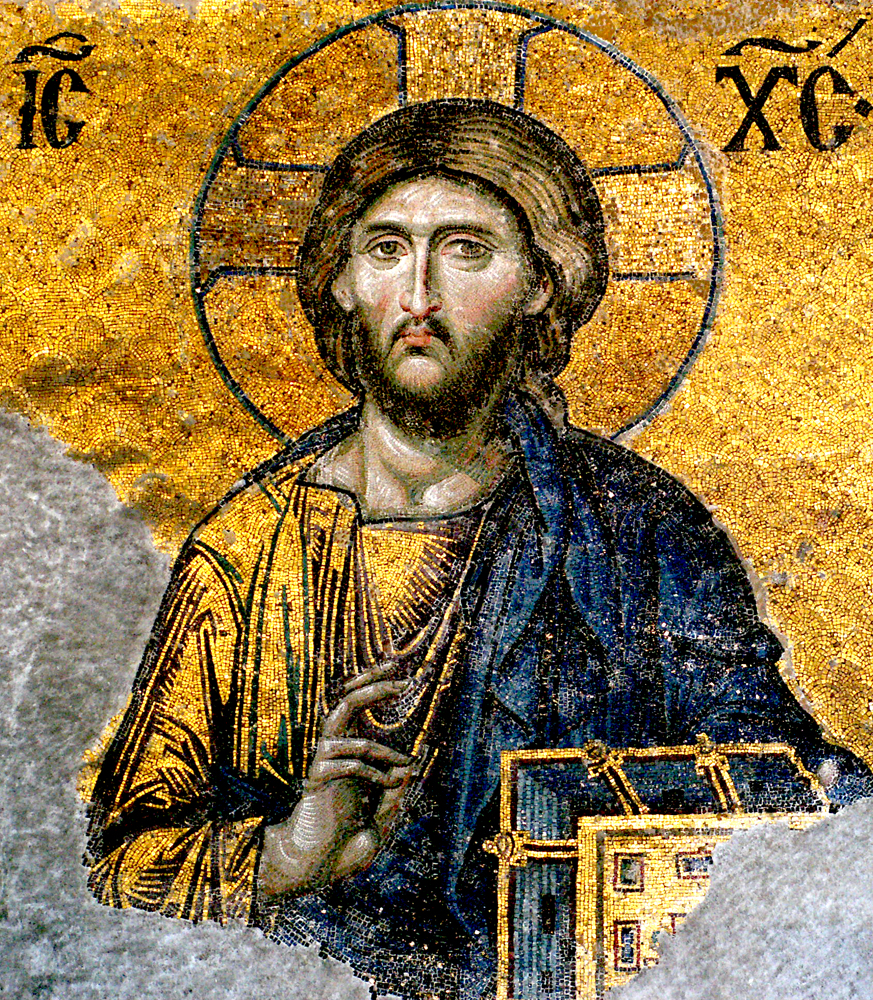|
Tapestry Of Creation
The Tapestry of Creation or Girona Tapestry is a Romanesque panel of needlework from the 11th century, housed in the Museum of the Cathedral of Girona, Catalonia, Spain. Measuring , it originally may have served as a baldachin for the Altar of the Holy Cross in the church's entrance. Some believe that it was used as a curtain or even a carpet. It depicts a series of theological scenes related with the Christian creation myths. The "tapestry" is actually a panel of couched needlework laid down on the surface of the ground fabric, a terracotta wool intertwined with different colors (red, green, yellow, dark and light blue, gray) wool and white linen threads. The border is formed by a frame, rather deteriorated, containing small square pictures which, according to some scholars, could have been added later to the central sector, due to their different, Byzantine-like style and themes. The tapestry, of which only the upper part remains, is divided into three cycles: *the Genesi ... [...More Info...] [...Related Items...] OR: [Wikipedia] [Google] [Baidu] |
Genesis Creation Narrative
The Genesis creation narrative is the creation myth of both Judaism and Christianity. The narrative is made up of two stories, roughly equivalent to the first two chapters of the Book of Genesis. In the first, Elohim (the Hebrew generic word for God) creates the heavens and the Earth in six days, then rests on, blesses, and sanctifies the seventh (i.e. the Biblical Sabbath). In the second story God (now referred to by the personal name Yahweh) creates Adam, the first man, from dust and places him in the Garden of Eden. There he is given dominion over the animals. Eve, the first woman, is created from Adam’s rib as his companion. The Hebrew creation narrative borrowed themes from Mesopotamian mythology, but adapted them to their unique belief in one God. The first major comprehensive draft of the Pentateuch (the series of five books which begins with Genesis and ends with Deuteronomy) is thought to have been composed in the late 7th or the 6th century BCE (the Jahwist sour ... [...More Info...] [...Related Items...] OR: [Wikipedia] [Google] [Baidu] |
11th-century Works
The 11th century is the period from 1001 ( MI) through 1100 ( MC) in accordance with the Julian calendar, and the 1st century of the 2nd millennium. In the history of Europe, this period is considered the early part of the High Middle Ages. There was, after a brief ascendancy, a sudden decline of Byzantine power and a rise of Norman domination over much of Europe, along with the prominent role in Europe of notably influential popes. Christendom experienced a formal schism in this century which had been developing over previous centuries between the Latin West and Byzantine East, causing a split in its two largest denominations to this day: Roman Catholicism and Eastern Orthodoxy. In Song dynasty China and the classical Islamic world, this century marked the high point for both classical Chinese civilization, science and technology, and classical Islamic science, philosophy, technology and literature. Rival political factions at the Song dynasty court created strife amongst t ... [...More Info...] [...Related Items...] OR: [Wikipedia] [Google] [Baidu] |
Embroidery
Embroidery is the craft of decorating fabric or other materials using a needle to apply thread or yarn. Embroidery may also incorporate other materials such as pearls, beads, quills, and sequins. In modern days, embroidery is usually seen on caps, hats, coats, overlays, blankets, dress shirts, denim, dresses, stockings, scarfs, and golf shirts. Embroidery is available in a wide variety of thread or yarn colour. Some of the basic techniques or stitches of the earliest embroidery are chain stitch, buttonhole or blanket stitch, running stitch, satin stitch, and cross stitch. Those stitches remain the fundamental techniques of hand embroidery today. History Origins The process used to tailor, patch, mend and reinforce cloth fostered the development of sewing techniques, and the decorative possibilities of sewing led to the art of embroidery. Indeed, the remarkable stability of basic embroidery stitches has been noted: The art of embroidery has been found worldwide and ... [...More Info...] [...Related Items...] OR: [Wikipedia] [Google] [Baidu] |
Cain
Cain ''Káïn''; ar, قابيل/قايين, Qābīl/Qāyīn is a Biblical figure in the Book of Genesis within Abrahamic religions. He is the elder brother of Abel, and the firstborn son of Adam and Eve, the first couple within the Bible. He was a farmer who gave an offering of his crops to God. However, God was not pleased and favored Abel's offering over Cain's. Out of jealousy, Cain killed his brother, for which he was punished by God with the curse and mark of Cain. He had several children, starting with Enoch and including Lamech. The narrative is notably unclear on Cain's motive for murdering his brother, God's reason for rejecting Cain's sacrifice, and details on the identity of Cain's wife. Some traditional interpretations consider Cain to be the originator of evil, violence, or greed. According to Genesis, Cain was the first human born and the first murderer. Genesis narrative Interpretations Jewish and Christian interpretations A question arising early in the ... [...More Info...] [...Related Items...] OR: [Wikipedia] [Google] [Baidu] |
Abel
Abel ''Hábel''; ar, هابيل, Hābīl is a Biblical figure in the Book of Genesis within Abrahamic religions. He was the younger brother of Cain, and the younger son of Adam and Eve, the first couple in Biblical history. He was a shepherd who offered his firstborn flock up to God as an offering. God accepted his offering but not his brother's. Cain then killed Abel out of jealousy. According to Genesis, this was the first murder in the history of mankind. Genesis narrative Interpretations Jewish and Christian interpretations According to the narrative in Genesis, Abel ( ''Hébel'', in pausa ''Hā́ḇel''; grc-x-biblical, Ἅβελ ''Hábel''; ar, هابيل, ''Hābēl'') is Eve's second son. His name in Hebrew is composed of the same three consonants as a root meaning "breath". Julius Wellhausen has proposed that the name is independent of the root. Eberhard Schrader had previously put forward the Akkadian (Old Assyrian dialect) ''ablu'' ("son") as a more li ... [...More Info...] [...Related Items...] OR: [Wikipedia] [Google] [Baidu] |
Samson
Samson (; , '' he, Šīmšōn, label= none'', "man of the sun") was the last of the judges of the ancient Israelites mentioned in the Book of Judges (chapters 13 to 16) and one of the last leaders who "judged" Israel before the institution of the monarchy. He is sometimes considered as an Israelite version of the popular Near Eastern folk hero also embodied by the Sumerian Enkidu and the Greek Heracles. The biblical account states that Samson was a Nazirite, and that he was given immense strength to aid him against his enemies and allow him to perform superhuman feats, including slaying a lion with his bare hands and massacring an entire army of Philistines using only the jawbone of a donkey. However, if Samson's long hair were cut, then his Nazirite vow would be violated and he would lose his strength. Samson is betrayed by his lover Delilah, who, sent by the Philistines officials to entice him, orders a servant to cut his hair while he is sleeping and turns him over to hi ... [...More Info...] [...Related Items...] OR: [Wikipedia] [Google] [Baidu] |
Rivers Of Paradise
Rivers of Paradise (also The four Rivers of Paradise) are the four rivers described in Genesis 2:10-14, where an unnamed stream flowing out of Garden of Eden splits into four branches: Pishon, Gihon, Hiddekel (Tigris), and Phrath (Euphrates). These four rivers form a feature of the Garden that is popular in the Abrahamic religions. Geography Although some commentators dismiss the geographic attribution for the Garden of Eden entirely, a considerable amount of research was done on matching the rivers in the Genesis to the real ones, on the premise that the Garden was "obviously a geographic reality" to a writer of the Genesis verse (as well as his source), and thus dismissing the physical placement of the rivers is the contribution of the interpreters. To the second group of scholars, attribution of Euphrates is without a doubt, most of them agree on the Tigris (Hiddekel), but the identification of Pishon and Gihon is ambiguous. For religious scholars, a natural question "how did ... [...More Info...] [...Related Items...] OR: [Wikipedia] [Google] [Baidu] |
Wheel Of Time
The wheel of time or wheel of history (also known as ''Kalachakra'') is a concept found in several religious traditions and philosophies, notably religions of Indian origin such as Hinduism, Jainism, Sikhism, and Buddhism, which regard time as cyclical and consisting of repeating ages. Many other cultures contain belief in a similar concept: notably, the Q'ero Natives of Peru, as well as the Hopi Natives of Arizona. Hinduism In Hindu cosmology, ''kala'' (time) is eternal, repeating general events in four types of cycles. The smallest cycle is a '' maha-yuga'' (great age), containing four ''yugas'' (''dharmic'' ages): ''Satya Yuga'', ''Treta Yuga'', ''Dvapara Yuga'' and ''Kali Yuga''. A ''manvantara'' (age of Manu) contains 71 ''maha-yugas''. A ''kalpa'' (day of Brahma) contains 14 ''manvantaras'' and 15 ''sandhyas'' (connecting periods), which lasts for 1,000 ''maha-yugas'' and is followed by a ''pralaya'' (night of partial dissolution) of equal length, where a day and night ... [...More Info...] [...Related Items...] OR: [Wikipedia] [Google] [Baidu] |
Adam And Eve
Adam and Eve, according to the creation myth of the Abrahamic religions, were the first man and woman. They are central to the belief that humanity is in essence a single family, with everyone descended from a single pair of original ancestors. They also provide the basis for the doctrines of the fall of man and original sin that are important beliefs in Christianity, although not held in Judaism or Islam. In the Book of Genesis of the Hebrew Bible, chapters one through five, there are two creation narratives with two distinct perspectives. In the first, Adam and Eve are not named. Instead, God created humankind in God's image and instructed them to multiply and to be stewards over everything else that God had made. In the second narrative, God fashions Adam from dust and places him in the Garden of Eden. Adam is told that he can eat freely of all the trees in the garden, except for a tree of the knowledge of good and evil. Subsequently, Eve is created from one of Adam's ri ... [...More Info...] [...Related Items...] OR: [Wikipedia] [Google] [Baidu] |
Christ Pantocrator
In Christian iconography, Christ Pantocrator ( grc-gre, Χριστὸς Παντοκράτωρ) is a specific depiction of Christ. ''Pantocrator'' or ''Pantokrator'', literally ''ruler of all'', but usually translated as "Almighty" or "all-powerful", is derived from one of many names of God in Judaism. The Pantokrator, largely an Eastern Orthodox or Eastern Catholic theological conception, is less common under that name in Western Roman Catholicism and largely unknown to most Protestants. In the West, the equivalent image in art is known as Christ in Majesty, which developed a rather different iconography. ''Christ Pantocrator'' has come to suggest Christ as a mild but stern, all-powerful judge of humanity. When the Hebrew Bible was translated into Greek as the Septuagint, ''Pantokrator'' was used both for ''YHWH Sabaoth'' " Lord of Hosts" and for '' El Shaddai'' " God Almighty". In the New Testament, ''Pantokrator'' is used once by Paul () and nine times in the Book of Re ... [...More Info...] [...Related Items...] OR: [Wikipedia] [Google] [Baidu] |
Byzantine Art
Byzantine art comprises the body of Christian Greek artistic products of the Eastern Roman Empire, as well as the nations and states that inherited culturally from the empire. Though the empire itself emerged from the decline of Rome and lasted until the Fall of Constantinople in 1453, the start date of the Byzantine period is rather clearer in art history than in political history, if still imprecise. Many Eastern Orthodox states in Eastern Europe, as well as to some degree the Islamic states of the eastern Mediterranean, preserved many aspects of the empire's culture and art for centuries afterward. A number of contemporary states with the Byzantine Empire were culturally influenced by it without actually being part of it (the "Byzantine commonwealth"). These included the Rus, as well as some non-Orthodox states like the Republic of Venice, which separated from the Byzantine Empire in the 10th century, and the Kingdom of Sicily, which had close ties to the Byzantine Empire a ... [...More Info...] [...Related Items...] OR: [Wikipedia] [Google] [Baidu] |










